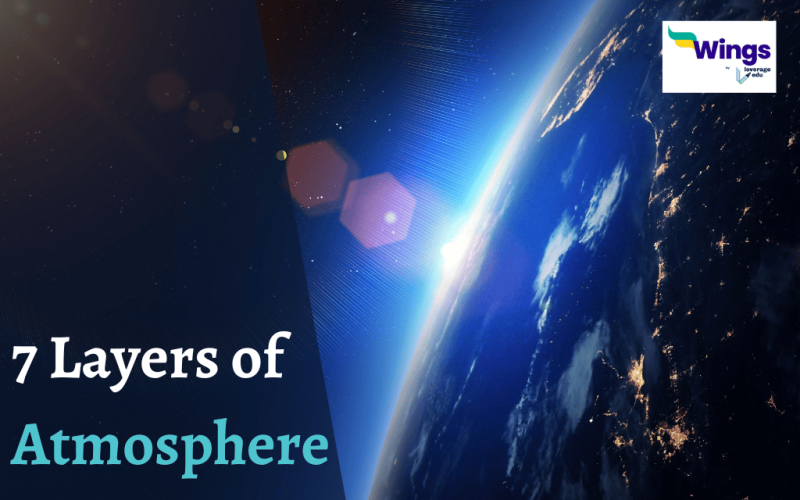Do you know that the possibility of life on Earth is one in a million??? Besides that, do you know what makes this scarce chance possible? It is the unique combination of Water, Land and Air that forms the Biosphere making life possible on Earth.
Also, a major part of the Biosphere is Atmosphere. It protects us from direct outer space, deflects Sun’s harmful rays and makes the sky so colourful and inspiring for us. It is a blanket around the Earth that helps scatter the sunlight and disperse it to spread across the lands and water. Meteorologists study these phenomena daily to bring new studies to us.
Basically, without atmosphere, we would be peering at a pitch-black outer space each day. That too, if we had existed in those conditions. Due to this immense importance, it is imperative to study the composition of the atmosphere and discover what lies in the 7 layers of the atmosphere.
Table of Contents [show]
Also Read: Celestial Bodies: Planets, Comets, Asteroids and More
7 Layers of the Atmosphere
Do you often wonder what lies in the 7 layers of the atmosphere? Making it strong enough to deflect UV rays, and send radio signals and satellite signals. Also making it difficult for space objects to enter Earth and provide a cushiony way for the aircraft at the same time. Let’s explore these layers.
Troposphere
This part of the atmosphere is directly in contact with us and most of the weather changes happen in this layer. It is extended upto 7-10 km from the Earth’s surface nearing at poles and farther at the equator. The top of the troposphere is called Tropopause.
| Layer | Troposphere |
| Height | 0-12 km |
| Key function | Weather changes |
| Feature | Contains 75% of all the air |
Stratosphere
Above the Tropopause and upto nearly 50 km is the Stratosphere. This layer is rich in Ozone and deflects the harmful UV rays of the sun. The aeroplanes fly in this layer of the atmosphere as it is situated above the clouds.
| Layer | Stratosphere |
| Height | 12-50 km |
| Key function | Deflects UV rays |
| Feature | Aeroplanes fly in this zone |
Mesosphere
The layer above the stratosphere is called the Mesosphere. Temperature decreases with height In this atmospheric layer as well. It can go as low as -90 degree Celsius. It stretches from 50-80 km above the Earth’s surface and its topmost layer is known as Mesopause. Also, this is the layer where most of the meteors burn up in the atmosphere. It also has a layer of noctilucent clouds formed with the few water vapours at that height. This is the highest where clouds can be formed.
| Layer | Mesosphere |
| Height | 50-80 km |
| Key function | Burns meteors |
| Feature | Forms noctilucent clouds |
Also Read: What is the Distance Between Moon and Earth?
Thermosphere
Stretching 80 to 700 km in the vast space Thermosphere is a wide belt of atmosphere. It is also the layer where the International Space Station orbits. Contrary to other counterparts, the temperature in this layer rises with height. The aurora borealis and aurora australis are occasionally seen here.
| Layer | Thermosphere |
| Height | 80-700 km |
| Key function | Northern & Southern lights are occasionally visible in this layer |
| Feature | International Space Station orbits here |
Ionosphere
The Ionosphere is an interesting belt that exists in the lower section of the Thermosphere. It is equipped with positively charged ions. This happens because solar radiation breaks the molecules and atoms to release these ions. However, these ions play a major role in reflecting audio signals and are used in radio wave transmission.
| Layer | Ionosphere |
| Height | 80 km |
| Key function | Absorbs UV and X-Rays |
| Feature | Reflects radio signals |
Exosphere
The outer space interacts with our atmosphere through the Exosphere. This is the layer beyond Thermosphere and hardly contains any atoms or molecules. The Oxygen and Hydrogen atoms in this layer are so scarce that they hardly interact. It merges with the solar wind at its top and very low density of molecules. Auroras are often spotted in the lower layers of the exosphere. It is also the layer where most of our satellites orbit.
| Layer | Exosphere |
| Height | 700-10,000 km |
| Key function | Auroras are formed here |
| Feature | Suitable for satellite orbit |
Magnetosphere
The magnetic behaviour of the Earth is familiar to all of us. Because of that, it attracts several charged particles that revolve in magnetic fields around the Earth. The layer they form is called the Magnetosphere. These are also called Van Allen Radiation Belts.
| Layer | Magnetosphere |
| Height | 3,000-6,000 km |
| Key function | Protects erosion of atmosphere from Solar Radiation |
| Feature | Protects from solar and cosmic particle radiations |
For more such informative blogs on Science and Technology stay tuned to our General Knowledge section.
 One app for all your study abroad needs
One app for all your study abroad needs















 45,000+ students trusted us with their dreams. Take the first step today!
45,000+ students trusted us with their dreams. Take the first step today!
